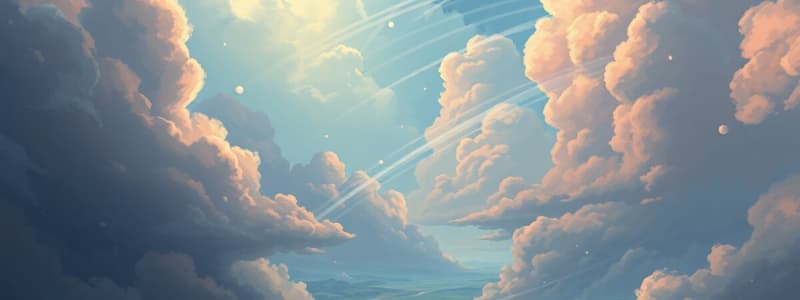Podcast
Questions and Answers
What is the main cause of wind formation near the Earth's surface?
What is the main cause of wind formation near the Earth's surface?
- Unequal heating of the atmosphere
- Movement of ocean currents
- The Coriolis effect
- Differences in air pressure (correct)
What weather conditions are typically associated with a high pressure system?
What weather conditions are typically associated with a high pressure system?
- Foggy and humid
- Clear and dry (correct)
- Stormy with severe winds
- Cloudy and rainy
How do hurricanes typically form?
How do hurricanes typically form?
- From fronts in mid-latitude regions
- From patches of warm ocean water (correct)
- From high pressure systems
- From cold air moving over warm water
What effect does the Coriolis effect have on wind movement in the Northern Hemisphere?
What effect does the Coriolis effect have on wind movement in the Northern Hemisphere?
What happens to air in a low pressure system?
What happens to air in a low pressure system?
What describes the formation of a stationary front?
What describes the formation of a stationary front?
What is the eye of a hurricane?
What is the eye of a hurricane?
What is true about maritime air masses?
What is true about maritime air masses?
Flashcards
High-pressure system
High-pressure system
Air descends, creating clear and dry weather. Highs rotate clockwise.
Low-pressure system
Low-pressure system
Air ascends, leading to condensation and precipitation. Lows rotate counterclockwise in the Northern Hemisphere.
Coriolis effect
Coriolis effect
Moving objects appear deflected to the right in the Northern Hemisphere and left in the Southern Hemisphere. Affects wind patterns.
Convection current
Convection current
Signup and view all the flashcards
Air mass types
Air mass types
Signup and view all the flashcards
Hurricane
Hurricane
Signup and view all the flashcards
Stationary front
Stationary front
Signup and view all the flashcards
Warm front
Warm front
Signup and view all the flashcards
Study Notes
Pressure, Density, and Temperature
- Unequal heating of Earth's surface creates different air pressures.
- Unequal heating is due to Earth's curvature and differences in land and water heating.
- Differences in air pressure cause winds.
- High-pressure air moves toward low-pressure areas.
- Warmer, less dense air rises, creating low-pressure areas.
- Cooler, denser air sinks, creating high-pressure areas.
Air Masses
- Continental air masses are dry.
- Maritime air masses are humid.
- Polar air masses are cooler.
- Tropical air masses are warmer.
Winds at Top of Troposphere and Earth's Surface
- Winds at the top of the troposphere are affected by the Coriolis effect.
- High-pressure systems descend, creating clear and dry weather; clockwise rotation (in the Northern Hemisphere).
- Low-pressure systems ascend, creating precipitation; counterclockwise rotation (in the Northern Hemisphere).
- Jet Stream is the fastest current in the Earth's higher atmosphere. The jet stream is important in the movement of weather systems around the planet.
Tropical Lows/Hurricanes
- Tropical lows are created by warm ocean water.
- The Coriolis effect makes the low-pressure systems rotate.
- Hurricanes form when wind speeds reach 74 mph.
- A hurricane's eye is a calm center surrounded by a wall of ascending warm air.
- Air from every direction is drawn to a hurricane's center.
Mid-Latitude Lows
- Mid-latitude lows are usually created by fronts.
Fronts
- Stationary front: air masses move sideways, producing cloudy/gloomy weather.
- Warm front: slow-moving, producing steady rain.
- Cold front: fast-moving, producing storms.
- Occluded front: warm air is trapped above the ground.
Cumulonimbus Clouds
- Formed by updrafts (rising air).
- Have downdrafts (falling air).
- Upper level winds cause air to rotate, creating a supercell.
Studying That Suits You
Use AI to generate personalized quizzes and flashcards to suit your learning preferences.




